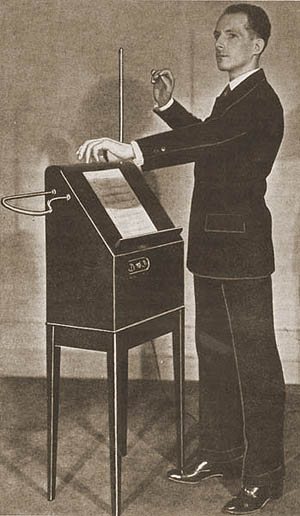In 1920, a Russian physicist named Leon Theremin came to the West at the behest of Lenin. Russia was largely seen by the West as culturally and technologically backward and Lenin wanted to change that perception. Theremin was also an inventor and had developed an electronic instrument quite unlike any before or since. Perhaps the only instrument that does not require the player to touch it in any fashion. The player instead moves his or her body in the space surrounding the instrument to alter its pitch and amplitude. Any movement of the body will register as a sound and so the instrument is difficult to play but, because the player is entirely freed from contact with the instrument, is extremely expressive. The sound is human-like, flute-like, violin-like and yet like none of these. Unmistakably electronic. The instrument is called, appropriately, the theremin.

Leon Theremin playing the theremin. The two perpendicular antennas pick up the movements of the player’s body—hands and arms in particular. The vertical antenna controls pitch and the horizontal one controls volume. The antennas control these parameters by means of oscillators. The closer to the antennas one places ones hands increases the volume or pitch frequency proportionally but completely independently of one another. The odd whistling tone has been used in many early sci-fi movies and also the theme song of
My Favorite Martian as well as on the Beach Boys’
Good Vibrations.

Theremins are still very popular and this one is built from a kit. Thanks to technological advances, theremins are far more compact today.
Clara Rockmore plays “The Swan” by Saint-Saëns on the theremin:
Theremin - Clara Rockmore play "The Swan" (Saint-Saëns) - YouTube
Theremin came to the United States and patented his instrument in 1928 to RCA.